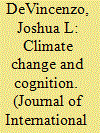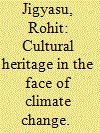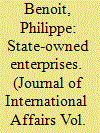|
|
|
Sort Order |
|
|
|
Items / Page
|
|
|
|
|
|
|
| Srl | Item |
| 1 |
ID:
170848


|
|
|
| 2 |
ID:
170843


|
|
|
| 3 |
ID:
170838


|
|
|
|
|
| Summary/Abstract |
In the aftermath of 9/11, the National Center for Disaster Preparedness (NCDP), and the Earth Institute of Columbia University launched the American Preparedness Project in order to survey public perceptions on disaster preparedness. The report found that 65% of Americans expressed worry that climate change will have an impact on their community's exposure to disasters. The NCDP recommended integrating the impact of climate change into communications and preparedness programs, given that a comprehensive understanding of the concerns of individuals and families is critical to emergency planning efforts. The NCDP adopted a user-centered design approach to create more informed risk communications and instructional decisions to work towards a pedagogy of climate change. Today, the NCDP deploys online and in-person trainings across the United States where the Center directly engages with the public on disaster preparedness, response, recovery, and resiliency. Leveraging these experiences, the NCDP collects data to analyze the learning efficacy of communication methods of disaster focused curricula. However, despite these strides toward a methodology of teaching climate change, there are several discrepancies in the U.S. public opinion on the degree of urgency in which to prepare for the risks of climate change. Discrepancies are tied to a multitude of factors including partisan affinity, dynamics of in-group or out-group, impersonal versus personal interaction, and perceived thresholds of distance and time. A key relationship between public discourse, cognition, and instruction are introduced in this paper to better set the foundation for a pedagogy of climate change. This paper also provides data-driven recommendations derived from satisfaction surveys and belief statements from learners that have participated in the NCDP's course content on climate change. The recommendations focus on risk communication strategies that can adequately address public opinion discrepancies on the risk of climate change, impact decision making, as well as improve learner understanding of climate change. The solution is not simply to provide more information but to evaluate how to implement different delivery methods aligned with public learning needs and capacities.
|
|
|
|
|
|
|
|
|
|
|
|
|
|
|
|
| 4 |
ID:
170850


|
|
|
|
|
| Summary/Abstract |
Political leaders describe the climate crisis as the greatest challenge of our time, but it plays only a marginal role in the foreign policy of most states and in the scholarly literature on international relations. Only 0.77 percent of the articles in five top international relations (IR) journals between 2015 and 2019 were about climate change. This is a problem, for when the full impact of climate change and policy responses to climate change is felt, it will redefine international politics. We suggest five broad areas where it is necessary to better understand how climate change will reshape world politics: sovereignty, security, status and reputation, norms and coalitions, and the geopolitics of energy.
|
|
|
|
|
|
|
|
|
|
|
|
|
|
|
|
| 5 |
ID:
170841


|
|
|
| 6 |
ID:
170844


|
|
|
| 7 |
ID:
170839


|
|
|
|
|
| Summary/Abstract |
Climate change is defined by the Intergovernmental Panel on Climate Change (IPCC) as "a change in the state of the climate that can be identified (e.g., using statistical tests) by changes in the mean and/or the variability of its properties, and that persists for an extended period, typically decades or longer"1. Climate change encompasses more than a worldwide trend of rising temperatures or 'global warming,' to include changes in regional climate characteristics such as humidity, rainfall and wind, and an observed increase in the frequency of extreme weather events, which will have biophysical, social, and economic impacts.2 However, climate change is not a figment of imagination of a distant future. Today, we are faced with rising sea levels, extreme temperatures, and more frequent and intense hydro-meteorological hazards that are already taking their toll on cultural heritage. Unfortunately, the scenarios presented by climate scientists are rather gloomy and the extent of impact on cultural heritage is likely to further accelerate exponentially. Using various case examples, this paper will explain how climate change is creating environmental conditions that are increasing the vulnerability of cultural heritage to various hazards, thereby exposing it to various risks. While there is a definite need to continue undertaking further research through a collection of highly calibrated data and sophisticated modelling for developing probable climate change induced scenarios for the future, it is equally important to invest in translating our progressively enhanced understanding of climate change risks into simple, achievable practices for day-to-day management of cultural heritage. These would include various preventive conservation techniques, enhanced monitoring systems, and adaptation strategies. Equally important is to rediscover and adapt traditional knowledge that has evolved over time in response to changing constraints and opportunities. This paper will showcase various practices from around the world to learn from their success and failure in dealing with the challenges posed by climate change.
|
|
|
|
|
|
|
|
|
|
|
|
|
|
|
|
| 8 |
ID:
170837


|
|
|
|
|
| Summary/Abstract |
Every U.S. President in recent decades has had to respond to at least one pandemic disease. Political leadership has proven decisive. In the coming years, U.S. foreign policy will face at least three inter-related issues: today's major pandemics of AIDS, TB, and Malaria; future outbreaks with the potential to become pandemics; and rising risk from infectious diseases associated with climate change. A review of epidemiologic data shows global progress on each issue is threatened. A coordinated U.S. effort, across agencies and engaged with national and multilateral partners, could save lives and address significant foreign policy interests. Such an effort could boost economic prosperity by reducing disease-related lost productivity, which we estimate at $1.7 trillion, with returns to investment in pandemic-related global health efforts averaging 17–20 to 1. Foreign policy focus on pandemics could also address economic and social inequalities and support climate adaptation and mitigation. Pandemic-related global health spending is 0.19% of the U.S. budget—a figure that has been flat in recent years even with growing needs and significant potential gains from investment.
|
|
|
|
|
|
|
|
|
|
|
|
|
|
|
|
| 9 |
ID:
170852


|
|
|
| 10 |
ID:
170836


|
|
|
|
|
| Summary/Abstract |
Fast economic growth in highly populous regions is triggering enormous needs in power generation, transport, and construction. These regions taken together account for over 60% of global greenhouse gas emissions, with 70% of these emissions emanating from carbon–intensive infrastructure. It is imperative that the development of sustainable infrastructure be accelerated, if we are to avoid the risk of locking–in high–emissions economic development pathways for decades to come.
Unfortunately, scaling up finance for investment in sustainable infrastructure assets has been too slow. It is therefore urgent to establish a new framework to create the right environment for scaling up the development of sustainable infrastructure projects aligned with the Paris Agreement and to mobilize the necessary financing, particularly from the private sector, which is critical to ensure an economy–wide transformation. Based on the work of the One Planet Lab, this essay proposes a holistic framework, which covers the demand side (the generation of bankable projects) as well as the supply side (the provision of financing). Among the essential aspects are encouraging the development of investment–grade assets, embedding sustainability in infrastructure planning, and effective project preparation.
This essay suggests action in two coordinated steps. First, generating the policy frameworks to swiftly channel capital towards sustainable infrastructure. Second, to bring together key stakeholders that will allow the mobilization of finance, including development finance institutions, multilateral and national development banks, private financial institutions, institutional investors, and digital finance innovators.
|
|
|
|
|
|
|
|
|
|
|
|
|
|
|
|
| 11 |
ID:
170835


|
|
|
|
|
| Summary/Abstract |
Combating climate change at a global scale requires dramatic
mobilization of capital markets. By 2035, more than $53 trillion will need to
be invested in energy supply and efficiency in order to achieve climate targets
laid out in the 2015 Paris Agreement. Interest and participation in sustainable
finance continues to grow: environmental, social, and governance (ESG)
investing assets under management totaled $30.7 trillion (of which $1 trillion is
specifically classified as sustainability-themed) at the start of 2018, representing
a 34% increase over the preceding two years. Yet, the capital that is available
for investment in sustainable assets may not be well-matched with the pipeline
of projects in search of financing. Green asset classes, including renewable
generation, infrastructure, energy efficiency, and clean transport, are often
inherently novel, small, and/or disaggregated. This makes them difficult and
expensive to combine into investment-ready formats, preventing capital from
being deployed on the timescale required to enable a quick energy transition.
Moreover, market barriers exist with respect to early-stage financing and proving
the viability of new markets and business models. In this article, we explore
the hurdles and barriers that financial actors must overcome to ensure efficient
capital matching that bridges the gap between climate awareness and meaningful
climate investment
|
|
|
|
|
|
|
|
|
|
|
|
|
|
|
|
| 12 |
ID:
170857


|
|
|
| 13 |
ID:
170846


|
|
|
| 14 |
ID:
170856


|
|
|
|
|
| Summary/Abstract |
Climate risk could potentially trigger another global financial crisis unless it is properly accounted for in global financial markets. U.S. policymakers should seek not only to reduce emissions but to also boost the climate resilience of physical infrastructure and mandate disclosure of climate-induced risk throughout the financial system.
|
|
|
|
|
|
|
|
|
|
|
|
|
|
|
|
| 15 |
ID:
170840


|
|
|
|
|
| Summary/Abstract |
Cultural heritage is about people. About the ones who built monuments and created art hundreds of years ago, and about the ones who identified with them today. It is identity for the locals and discovery for the foreigners. Cultural heritage moves tourism, local and national economies, and knowledge sharing. It helps to strengthen social inclusion, and resilient recovery after a crisis. However, it is facing a future of increasing risk. The impact of climate change on cultural heritage, both tangible and intangible, is a reality happening in many countries all around the world. From the effects of rising sea levels, to increasing storms and drought, a series of cultural heritage assets are under imminent threat. This paper will review the current situation of this matter, including examples of cultural heritage threatened by climate change worldwide, and will analyze potential solutions such as the integration of heritage into the disaster risk management discipline, as well as the role of culture and traditions in understanding and communicating disaster risk and climate change action, to strengthening resilience in local communities.
|
|
|
|
|
|
|
|
|
|
|
|
|
|
|
|
| 16 |
ID:
170842


|
|
|
|
|
| Summary/Abstract |
State-owned enterprises (SOEs), in the aggregate, emit more energy greenhouse gases than the entire European Union and every country except China. SOEs are also major providers of zero-carbon power and other low-carbon alternatives. Succeeding in the low-carbon transition will require their engagement. Yet, they receive relatively little attention in the global dialogue on climate mitigation. In contrast to private sector companies, many of these SOEs operate under conditions that mute the impact of carbon pricing mechanisms. Moreover, they have government owners that can and are willing to use their shareholder power to support low-carbon SOE action. These distinctive features of SOEs alter the suite of climate policies and instruments to influence their operations to lower emissions. Government ownership of SOEs can provide a useful avenue for effective climate action, with the right tools . . . but challenges exist, particularly government ambivalence about climate action. Given the important but under-appreciated and under-analyzed role that SOEs will have to play in reducing emissions, this paper will identify some of the opportunities and challenges in generating greater SOE engagement in the low-carbon transition, a climate outcome that cannot happen without them.
|
|
|
|
|
|
|
|
|
|
|
|
|
|
|
|
|
|
|
|
|